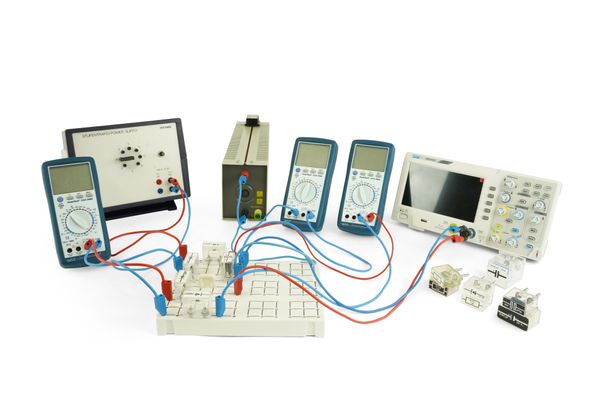|
Rectifier circuits

![]()
Principle
The ripple of the output voltage of various rectifier circuits is measured as a function of the load current strength and the charging capacitance. The characteristics of a voltage stabilizer and of a multiplier are investigated.
Benefits
- Get to know several types of rectifier circuits
- Suitable for vocational classes
Tasks
- Using the half-wave rectifier:
- To display the output voltage (without charging capacitor) on the oscilloscope.
- To measure the diode current I_d as a function of the output current strength I_0 (with the charging capacitor).
- To measure the ripple component U_ACpp of the output voltage as a function of the output current (C=constant).
- To measure the ripple as a function of the capacitance (I_0=constant).
- To measure the output voltage U_0 as a function of the input voltage U_i (I_0=0).
- Using the bridge rectifier:
- To display the output voltage (without charging capacitor) on the oscilloscope.
- To measure the current I_d through one diode as a function of the output current I_0 (with the charging capacitor).
- To measure the ripple of the output voltage as a function of the output current (C=constant).
- To measure the ripple as a function of the capacitance (I_0=constant).
- To measure the output voltage as a function of the input voltage.
- To measure the voltage U_c at the charging capacitor, and the output voltage of a stabilised voltage source as a function of the input voltage U_i.
- To measure the output voltage of a voltage multiplier circuit as a function of the input voltage.
Learning objectives
- Half-wave rectifier
- Full-wave rectifier
- Graetz rectifier
- Diode and Zener diode
- Avalanche effect
- Charging capacitor
- Ripple
- r.m.s. value
- Internal resistance
- Smoothing factor
- Ripple voltage
- Voltage stabilisation
- Voltage doubling
Scope of delivery
|
Plug-in board, for 4 mm plugs
|
06033-00
|
1
|
|
Semiconductor diode Si, 1 N 4007, case G1
|
39106-02
|
4
|
|
Electr.capaci. 470 microF/35V,G1
|
39105-26
|
1
|
|
Electrol.capacitor10microF/35V,G1
|
39105-28
|
4
|
|
Electrolyte capacitor 2000 µF/35V, G2
|
39113-08
|
1
|
|
Capacitor,electr.1mF/35V,G1
|
06049-09
|
1
|
|
Resistor 470 Ohm, 1W, G1
|
39104-15
|
1
|
|
Resistor 47 Ohm, 1W, G1
|
39104-62
|
1
|
|
Low power zener diode ZF 4,7, G1
|
39132-01
|
1
|
|
PHYWE Multitap transformer DC: 2/4/6/8/10/12 V, 5 A / AC: 2/4/6/8/10/12/14 V, 5 A
|
13533-93
|
1
|
|
Digital storage oscilloscope, 20 MHz, 2 channels, 100 MS/s
|
EAK-P-1335
|
1
|
|
PHYWE Digital multimeter, 600V AC/DC, 10A AC/DC, 20 MΩ, 200 µF, 20 kHz, −20°C…760°C
|
07122-00
|
3
|
|
Rheostat, 330 Ohm , 160 W
|
06116-03
|
1
|
|
Adapter, BNC male/4 mm female pair
|
07542-26
|
1
|
|
brigde plug
|
06027-07
|
3
|
|
Connecting cable, 32 A, red, various lengths
|
07360-01
|
2
|
|
Connecting cable, 32 A, blue, various lengths
|
07360-04
|
2
|
|
Connecting cable, 32 A, red, various lengths
|
07361-01
|
4
|
|
Connecting cable, 32 A, blue, various lengths
|
07361-04
|
4
|
|



